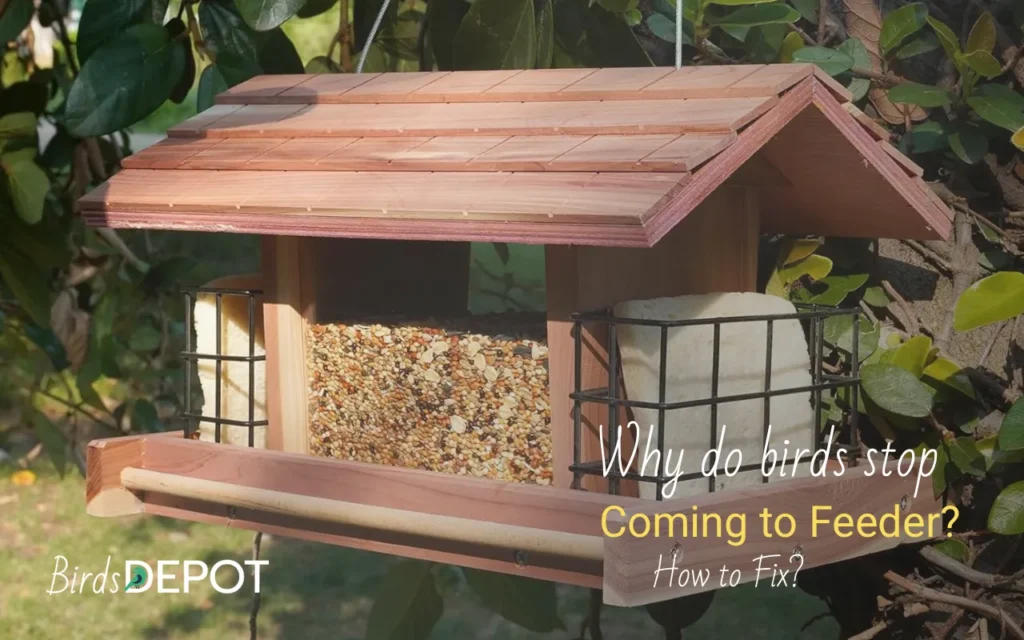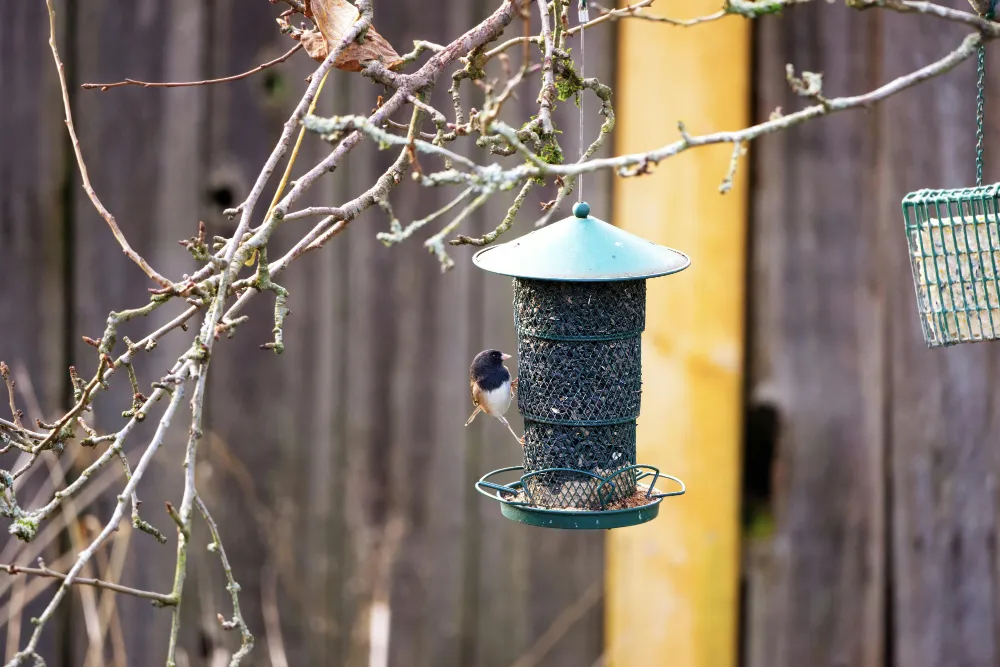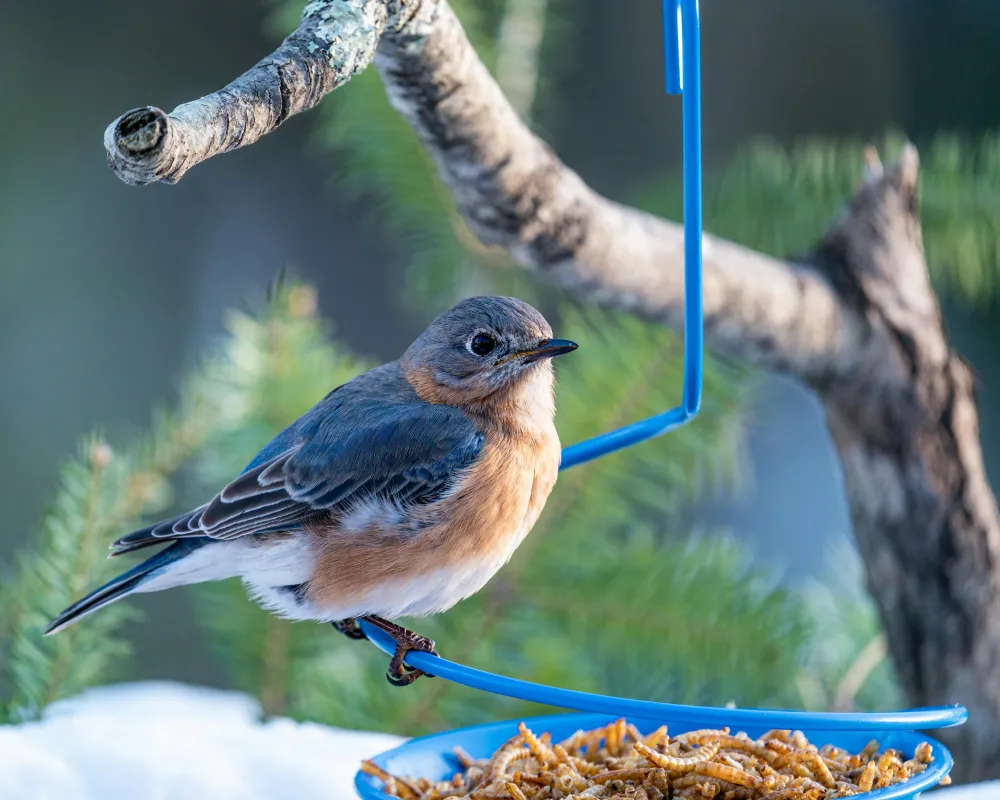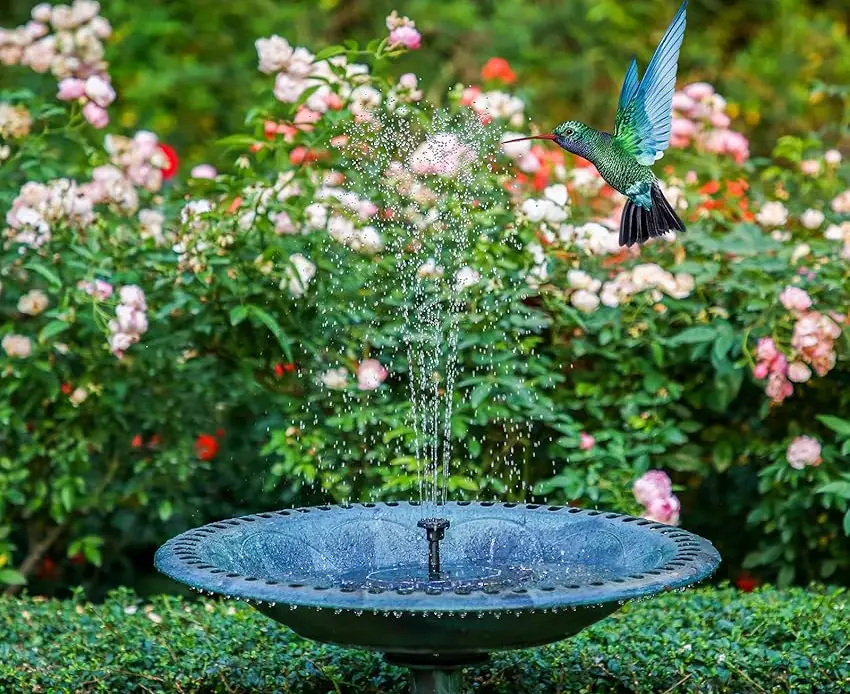Why do birds stop coming to the bird feeder? The Empty Feeder Mystery

The first time I hung a bird feeder in my garden, I expected an immediate flurry of colorful visitors. I’d carefully selected black oil sunflower seeds, supposedly a universal favorite, and positioned my new feeder where I could watch it from my kitchen window. Then I waited… and waited. My feeder swung empty in the breeze for two weeks, not a single feathered friend in sight.
If you’re experiencing something similar, you’re not alone. Many bird enthusiasts, whether beginners or seasoned bird watchers, face the disappointment of empty bird feeders. After years of trial and error (and quite a bit of research), I’ve discovered that attracting birds is both an art and a science, with numerous factors influencing whether birds will grace your garden with their presence.
In this blog, I’ll explore the common reasons birds might be avoiding your feeders and share practical solutions to help bring the birds back. Let’s solve the empty feeder mystery together!
Why do birds take time to adjust to a new bird feeder?
Often, people buy a new bird feeder and wonder how long it will take for birds to start using the feeder. The answer depends on several factors, including the time of year. In winter, birds are more likely to use a new feeder quickly due to food scarcity, whereas in other seasons, they may take longer to adjust. Birds instinctively avoid unfamiliar feeders at first, but brave species like black-capped chickadees usually test them out first, encouraging other birds to follow.

Seed choice also impacts bird activity. Safflower and niger seeds are recommended to deter blackbirds, squirrels, and raccoons, but they are not as universally preferred as sunflower chips. During the summer, when natural food sources are abundant, birds may take longer to use a new feeder, and seed consumption will be lower. In September and October, when wild seeds and berries are plentiful, feeders tend to be slower, and it may take weeks for birds to adapt to a new setup.
Understanding Seasonal Bird Behavior
Migration Patterns and Natural Food Availability
Birds are highly responsive to seasonal changes, which significantly impact their feeding habits. During spring and summer months, many species prioritize protein-rich insects over seeds to fuel breeding and nesting activities. Cornell University’s research shows that seed consumption can drop by up to 40% during nesting season.
My Experience: Last summer, I panicked when my usually busy feeders suddenly emptied. After consulting with my local Audubon Society chapter, I learned that the native berry bushes in my neighborhood were in full production, offering birds a preferred natural food source. Within weeks, as the berries diminished, my feathered friends returned.
Weather Influences on Feeding Patterns
Extreme weather conditions dramatically affect bird feeding behavior:
- During storms or high winds, birds often seek shelter rather than visit exposed feeders
- Unseasonably warm winters reduce birds’ caloric needs, resulting in fewer feeder visits
- Pre-storm feeding frenzies often occur 12-24 hours before bad weather arrives

Solution: Maintain consistent feeding throughout changing seasons. During summer months when visits decrease, reduce the amount of seed to prevent waste and spoilage, but don’t eliminate feeding entirely. Consider adding mealworms or fruit options during breeding season to attract insect-eating species.
Common Reasons for Abandoned Feeders
Food Quality Issues
The quality and freshness of bird food significantly impact feeder attendance. Birds have sophisticated ways of detecting spoiled or low-quality food:
- Seeds can become moldy or rancid within 1-2 months, especially in humid conditions
- Wet seeds develop harmful aflatoxins within 24-48 hours
- Birds can detect chemical changes in spoiled food and will avoid feeders with poor-quality seed
Solution: Purchase seed in quantities you can use within a month, store seed in cool, dry places in airtight containers, and inspect seed regularly for signs of mold or insect infestation. Consider investing in weather guards for feeders to keep seed dry during rainy periods.
Incorrect Seed Selection for Local Species
Different bird species have distinct preferences:
- Black oil sunflower seeds attract the widest variety (over 40 species)
- Nyjer (thistle) specifically attracts finches.
- Mixed seed efficacy varies widely (Cornell studies show waste rates of 30-60% for generic mixes)
- Suet is a nearly universal food that attracts many species, including woodpeckers, chickadees, nuthatches, and many others.
Personal Story: When I moved from the East Coast to the Southwest, I continued using the same seed mix that had been successful in my previous location. For weeks, my feeders remained untouched. After researching regional bird preferences, I switched to a desert bird blend with more millet and sunflower hearts. Within days, my yard was hosting house finches, curve-billed thrashers, and Gambel’s quail!
Suet Success: I added a simple suet feeder to my setup when all else failed during a particularly quiet period at my feeders. Within hours, I had woodpeckers, nuthatches, and even a few warblers I’d never seen before. Suet is the most reliable attraction across seasons and regions, especially in cooler weather when birds need high-energy foods.
Feeder Placement Problems
The location of your feeder can make or break your bird-attracting success:
- Too close to areas of high human activity (birds need a 10-15 foot buffer from regular human movement)
- Improper height placement (most songbirds prefer feeders 5-6 feet above ground)
- Lack of nearby cover or perching options (birds prefer feeders within 10-12 feet of protective cover)
- Exposure to elements (wind, rain, excessive sun)
- Window collision risks
- Birds need to see the feeder clearly but not feel dangerously exposed to predators
Solution: Position feeders near natural cover like shrubs or trees that provide both perching spots and quick escape routes from predators. Ensure feeders are visible to birds flying overhead but shielded from prevailing winds. To prevent window collisions, place feeders either within 3 feet of windows (too close for birds to build up fatal momentum) or more than 30 feet away.
Cleanliness and Maintenance Issues
Dirty feeders can actively repel birds and pose serious health risks:
- Bacteria and fungi grow on feeders within 2-3 days in warm, humid weather
- Salmonella outbreaks traced to bird feeders have affected thousands of birds
- Clogged feeding ports prevent seed from flowing properly
Maintenance Schedule:
- Hot soapy water cleaning every 2 weeks (minimum)
- 10% bleach solution disinfection monthly
- Immediate cleaning if sick birds observed (CDC recommendation)
- Regular clearing of seed debris beneath feeders
- Take down feeders when you go on vacation to prevent food from spoiling and potentially harming birds
The Critical Importance of Water
The Power of Adding a Birdbath
Water is a powerful bird attractor that is often overlooked by beginning bird enthusiasts:
- Birds need water for drinking and bathing, even in winter
- A birdbath can attract birds that might not otherwise visit feeders
- Moving or dripping water is especially attractive to birds
- Birds are drawn to the sound of water, which can be heard from greater distances than feeders can be seen

My Experience: After months of moderate feeder activity, I added a simple birdbath with a solar fountain attachment. The effect was almost magical—within days, my garden bird diversity doubled. Even during periods when feeder activity slows, the birdbath continues to draw visitors. I’ve observed that birds often discover my feeding station through the birdbath first, then explore the feeders afterward.
Birdbath Tips:
- Place birdbaths in semi-open areas where birds have clear sightlines but nearby cover for quick escape
- Keep water depth shallow (1-2 inches at most) with gradually sloping sides
- Add stones or branches to provide landing spots and varying depths
- Change water every 2-3 days to prevent mosquito breeding and disease spread
- In winter, use heated birdbaths in cold climates to provide crucial water when natural sources freeze
Special Considerations for Hummingbird Feeders
Maintaining Safe Nectar Feeders
If you’re lucky enough to have hummingbirds in your region, their feeding needs require special attention:
- Nectar must be kept fresh and clean to prevent potentially fatal tongue fungus
- Mildew can develop invisibly in nectar within days, particularly in warm weather
- Infected hummingbirds can develop a tongue fungus that causes their tongue to shrivel and fall out, resulting in death
Essential Hummingbird Feeder Maintenance:
- Clean hummingbird feeders thoroughly every 3-7 days (more frequently in hot weather)
- Use hot water and a bottle brush to clean all parts, avoiding soap when possible
- Disinfect monthly with a vinegar solution (1 part white vinegar to 4 parts water)
- Replace nectar completely with each cleaning, never just topping off old nectar
- Use proper nectar ratio (1 part white sugar to 4 parts water, boiled then cooled)
- Always take down hummingbird feeders before extended absences like vacations
Personal Approach: I keep multiple hummingbird feeders but only put out one or two at a time, allowing the others to be thoroughly cleaned and dried. This rotation system ensures I always have a clean feeder ready to go when it’s time to replace one in use.
Predator Presence: The Invisible Deterrent
Common Bird Feeder Predators
Predators can cause immediate and prolonged abandonment of feeding areas:
- Cats (domestic and feral) – responsible for 2.4 billion bird deaths annually in US
- Hawks (Cooper’s and Sharp-shinned hawks commonly target feeder birds)
- Squirrels and other mammals that may not directly prey on birds but create threatening disturbances
Signs of Predator Pressure:
- Sudden disappearance of all birds
- Birds exhibiting nervous behavior (frequent scanning, brief feeding)
- Birds freeze in place or give alarm calls before quickly fleeing
My Experience: Last winter, I noticed birds would visit my feeders in short, nervous bursts before suddenly disappearing completely for hours. After setting up a simple trail camera, I discovered a Cooper’s hawk was perching in a nearby spruce tree, using my feeders as its personal hunting ground. The birds had spotted the predator long before I did!
Solutions:
- Place feeders near protective cover but with clear sight lines so birds can spot approaching predators
- Consider cage-style feeders that protect smaller birds while feeding
- If hawk predation becomes severe, temporarily removing feeders for 1-2 weeks can encourage the hawk to hunt elsewhere
- Keep cats indoors or install “cat bib” devices that impede hunting success
Environmental and Habitat Factors
Neighborhood and Landscape Changes
Birds are highly sensitive to changes in their environment:
- Construction and development impacts (birds may take 2-4 weeks to return after nearby construction)
- Tree and vegetation removal effects (loss of nesting/roosting sites reduces local bird populations)
- Increased neighborhood disturbances (new pets, increased traffic, noise pollution)
- Seasonal landscape maintenance (leaf blowers and lawn equipment can disrupt feeding for 24-48 hours)
Solution: Create a bird-friendly habitat by incorporating native plants, minimizing chemical use, and providing multiple feeding stations throughout your property. Consider adding water features, which can increase overall bird activity by 50-80% according to Cornell studies.
Competition from Natural Food Sources
Seasonal abundance of natural foods often takes precedence over feeders:
- Berry-producing plants (birds often prefer natural food sources when available)
- Seed-producing trees and wildflowers
- Insect abundance periods
Finding Balance: Rather than competing with natural food sources, complement them by providing foods that may be seasonally scarce. When insects are plentiful in summer, mealworms are offered to attract parent birds to feed nestlings. In fall, provide high-fat foods to support migration. In winter, maintain reliable seed sources when natural foods are covered by snow.
Troubleshooting Your Feeder Setup
Diagnostic Approach to Feeder Problems
Take a systematic approach to identifying issues:
- Observe at peak activity times (dawn and dusk typically show 30-40% more activity)
- Keep a simple bird feeding journal noting species, numbers, behavior, time of day, and weather conditions
- Consider using a trail camera to monitor feeder activity when you’re not watching
- Participate in citizen science programs like Project FeederWatch to compare your results with local trends
Revitalizing Your Bird Feeding Station
Strategic Placement Techniques:
- Create a “feeding triangle” by placing different feeder types 10-15 feet apart
- Implement vertical stratification (different heights) to attract various species
- Add multiple feeding stations to prevent domination by aggressive species
- Include platform feeders for ground-feeding species like juncos and doves
Feeder Variety and Food Diversity:
- Tube feeders for finches and chickadees
- Platform feeders for larger birds like cardinals and jays
- Suet feeders for woodpeckers and nuthatches
- Hummingbird feeders during appropriate seasons
- Consider specialized feeders for specific target species
Personal Experience: After months of limited bird activity, I implemented what I call the “full-service bird restaurant” approach—multiple feeder types offering different foods at various heights. Within weeks, my bird diversity tripled, and my yard now hosts everything from tiny chickadees to impressive pileated woodpeckers!
Creating a Bird-Friendly Habitat
The most successful feeding stations are part of a larger bird-friendly environment:
Four Essential Habitat Elements
- Food – Both supplemental feeders and natural food sources
- Water – Bird baths, misters, or small ponds
- Shelter – Dense shrubs, evergreens, brush piles
- Nesting sites – Natural cavities, nest boxes, tall trees
Native Plant Integration
Native plants significantly enhance your bird-attracting efforts:
- They support 35 times more insect biomass than non-natives
- They produce berries and seeds specifically timed to birds’ seasonal needs
- They provide natural nesting materials and shelter
Simple Project Idea: Start small by replacing a conventional flower bed with native berry-producing shrubs like elderberry, dogwood, or serviceberry. These provide natural food sources and protection for birds while adding visual interest to your landscape.
Responsible Feeding Practices
When to Remove or Reduce Feeding
There are times when temporarily removing feeders is the most responsible choice:
- During extended absences like vacations (to prevent spoiled food from harming birds)
- If you notice signs of disease among visiting birds
- During seasons when bears or other potentially dangerous wildlife are active
- If you’re unable to maintain proper cleaning schedules
Planning Ahead: Rather than abruptly stopping feeding, gradually reduce the amount of food offered over several days before removing feeders completely. This gives birds time to find alternative food sources. When you resume feeding, start with small amounts and gradually increase to normal levels.
Patience and Persistence: The Bird Enthusiast’s Virtues
Remember that creating a bird-friendly environment is a journey, not an overnight success:
- New feeders may take 2-4 weeks to be discovered by birds
- Birds establish feeding patterns and routes that change slowly
- Consistent feeding, even when few birds visit, builds trust with local populations
- Seasonal fluctuations in visits are normal and expected
Conclusion: The Joy of Watching and Waiting
Creating a bird-friendly space requires patience, attention to detail, and a willingness to see your yard through birds’ eyes. When your feeders seem abandoned, use it as an opportunity to become a better observer and problem-solver. Each adjustment you make not only increases your chances of attracting birds but deepens your connection to the natural world around you.
Have you solved your own empty feeder mystery? What changes made the biggest difference in attracting birds to your yard? Share your experiences in the comments below or reach out with specific questions about your feeder setup. Let’s build a community of bird enthusiasts helping each other create havens for our feathered friends!
Since I got a Baffle that sits on top of the birdfeeder to keep the squirrels away, birds no longer come to the feeder. Are the birds scared of the Baffle?